Brazilian Filmmaker and Cinema Novo Giant is all in on Blu-ray
ALL FILMS DIRECTED BY JOAQUIM PEDRO DE ANDRADE/PORTUGUESE/1963 – 1981
BLU-RAY STREET DATE: SEPTEMBER 25, 2018/KINO CLASSICS
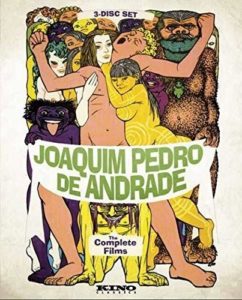
Eye-catching from the outset thanks to its cartoonishly decadent cover art, Joaquim Pedro de Andrade: The Complete Films is a comprehensive crash course in the work of one of the key directors of the Cinema Novo movement.
Cinema Novo, like most intentional film movements, was born of unrest and disenfranchisement with the vapid status quo of the national cinema in question. It’s been broken down into three phases; de Andrade making his greatest mark in the third phase, the phase most progressively divergent from what one might consider conventional coherency. But an understanding of Cinema Novo will only get one part of the way in terms of the film’s contained here. Furthermore, not all of de Andrade’s work falls into this camp. Some, in fact, is straight-up opposite. Nearly impossible to pin down in the conventional ways with which filmmakers are typically considered, de Andrade is evidenced to have been restless in both spirit and form, always challenging the viewer and likely himself.
In essence, what we’ve got here is a collection of wildly brazen narrative feature films and shorts (full of weird nudity and garish colors), and some wildly boring documentary shorts (subjective examinations narrated without emotion or excitement; the soulless staccato of a vintage educational record). Together, it is one filmmaker’s complete life’s work within his given medium- diverse yet localized; brimming with libido but short on heart. Considering that, according to Kino Lorber’s own listing of this set, “Andrade grew up in close contact with some of the country’s greatest artists, writers, and scholars”, perhaps this type of unexpected is the only thing to rightly be expected.
De Andrade loves to put characters into garish, colorful over-the-top outfits, and on frequent occasion, take them out of them. Sexual naughtiness and political satire are the key flavors in this celebrated Brazilian filmmaker’s oeuvre, the whole of which has been brilliantly restored, collected in one place, and presented chronologically across three Blu-ray discs by Kino Classics. The attractive set, Joaquim Pedro de Andrade: The Complete Films consists of five feature films and nine short films.
Disc 1
Garrincha: Joy of the People (1963)
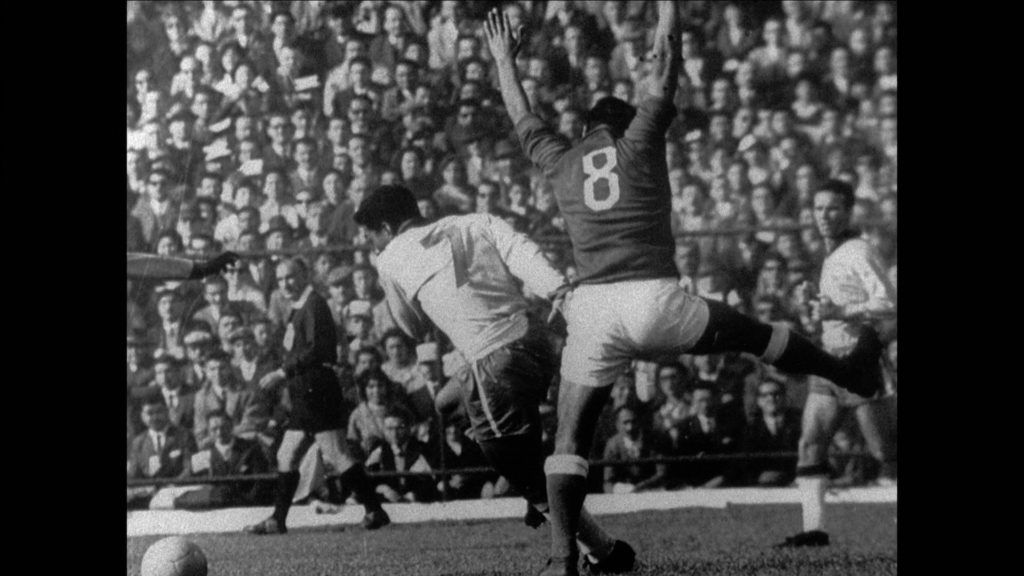
Garrincha: Joy of the People, the first film in the set, is a black and white sixty-minute documentary with the primary goal of enshrining the national soccer (football) star, Manuel Francisco dos Santos, nicknamed “Garrincha”. In its unerring and fetishized portrait of the popular athlete, we see an early penchant for skilled cuts, artistic compositions, and creative storytelling. Yet, even as Garrincha himself plays hard upon his pedestal of roaring fans, short shorts and dismissed teammates (with the necessary exception of teammate Pelé), Joy of the People somehow maintains a matter-of-fact quality. It’s employment of earlier match footage, including FIFA face-offs, is accompanied by a just-the-facts narration- assuming that the facts are rightly colored in the hues of this very specific hero worship.
The just-the-facts narration is something that de Andrade held onto in his occasional revisitation to the documentary form, albeit in short form from here on out.
*****
The Priest and the Girl (1965)

The Priest and the Girl is an altogether different beast; a quietly lurking one at that. It is, in fact, one of the absolute quietest films that this critic has ever seen. The only film of the set that blatantly evokes the work of Ingmar Bergman, The Priest and the Girl’s stock in trade is its cloistered examinations of illicit sex and religion in a small, country village. Like Bergman’s beloved Fårö, there’s a certain lunar quality to the surroundings- rock, stone, and patches of dirt peppered with the occasional cottages and quaint public structures. Also like much of Bergman, the black and white photography in which it’s rendered serves to subtly amplify the alienation of it all. Inescapably desolate, the glum, sparse nature of this established microcosm is intrinsically intertwined with the narrative. Like the de Andrade feature films to come, plot isn’t the filmmaker’s top priority as opposed to story; or more to the point, situational reality within his chosen construct. That said, The Priest and the Girl can be a tremendously deceptive anomaly in terms of what one should expect from subsequent films in this collection.
Too quiet for comfort (for the most part, The Priest and the Girl forgoes not only a musical score, but any dialogue), the film is a rather confident foray into narrative moviemaking, for sure. A village drama where the local pretty young girl’s sexual history is at the root of everyone’s interest, the truth of it all both hangs in balance and dares us not to care about it. The titular priest is a young transplant having newly arrived, replacing the recently deceased lecherous older village priest. The film’s central conflict is his interior struggle to resist his attraction to the girl in question. It is effective as a film, and by later de Andrade standards, altogether modest- though strong coffee might make for a wise accompaniment. The Priest and the Girl, though, is not and cannot be Bergman. Given time, perhaps de Andrade could’ve progressed further in this minimalist realm of the tortured soul. (Evidenced here, his use of close-ups during scenes of character action is unique). His path, though, proves to be entirely different, chucking most any semblance of the soulful, and instead hairpin turning into absurdism most unpleasant- if also darkly comical.
*****
The Poet of Castelo (1959)
This twelve-minute black and white short film tells the tale of a sad old man, alone in the world. Hanging on wide shots of soulless modern architecture, de Andrade infuses the alienation of Antonioni with a melodramatic and even rawly human touch. This film, perhaps better than any of the others, demonstrates de Andrade’s directorial acumen amongst his better known mid-century global peers. The Poet of Castelo is clearly a living work of influence to Italian Neo-Realism and early works of the French New Wave. More than that, though, like The Priest and the Girl, it cannot be overlooked that chronologically, it is more concurrent than not with these attributed influences. Of a piece, though, is the frankness the old man’s inner narration ( the only words spoken in the film) casually ponder in sexual longings, and he intends to do about it.
The Master of Apipucos (1959)
“ I never get tired of looking at the color of the sea“, narrates the aging male protagonist of The Master of Apipucos. Unlike the similar protagonist of The Poet of Castelo, this man has both human companionship and a degree of contentment with his life. And why not? Also a writer, he lives Oceanside in a large, cozy mansion. It is, in fact, a severed brother of The Poet of Castelo, as both were originally intended to play together, but for whatever reason, de Andrade broke them into standalone films. A strange choice, considering both the similarities in the two, as well as the fact that nothing happens in The Master of Apipucos. That said, it’s kind of nice to have a film devoid of any narrative tension, and not find it boring. If nothing else, de Andrade’s ability to pull this off points to the accomplished rebellious streak we’ll see later in work, both formally, thematically, and certainly politically. After all, this being a black and white film, we can never truly relate to this well-off man and his fondness for the color of the sea on a 1:1 level. Considering the filmmaker’s leftist beliefs, one wonders what isn’t being made explicit here.
Cat Skin (1960)
If you really love cats, it may be best to skip this one. Though never graphic in depiction, the plot through-line of young impoverished boys stealing cats to so that their skin can be used in making tambourines is inherently unsettling enough. Yes, cats both domestic and stray seem to be everywhere in the sprawling slum-land of Rio de Janeiro. The tricks employed by the young thieves range from resourceful to comedic in their failures. Sometimes, it’s your standard smash and grab, the cat going into a sack and taken away. All the while, de Andrade gives considerable attention to the cats themselves, humorously yet so familiar in their “otherness”. The ensuing foot chases are then set to tambourine pulsing. Morbid, maybe, but amusingly poignant as well. Eventually the story settles on a downtrodden kid who’s swiped a wealthy lady’s white Persian cat from her side. Before turning in the poor displaced feline, he bonds with it over a pitiful snack. But hesitantly, the kid goes about his business, albeit tearfully. Thus, the social message is driven home- what else can such a kid do?
Originally included in the feature-length Cinco vezes Favela, the fifteen-minute black and white Cat Skin is an exceedingly well-crafted outing, though also a heartbreaker.
Cinema Novo (1967)
Originally shot for German television under the title “Improvised and Purposeful”, 1967’s Cinema Novo is a thirty-three minute bit of verite journalism offering a surface exploration of its it namesake. Joaquim Pedro de Andrade was selected to direct this, no doubt due to his insider standing within the Cinema Novo movement itself. He’s never depicted in the documentary stories onscreen, though his contemporaries are. Covered are fellow local filmmakers Carlos Diegues, Glauber Rocha, Domingos Oliveira, Armaldo Jabor
and Leon Hirszman. In its quest to track “The state of film in a developing country”, Cinema Novo follows the financing, table reads, filming and post-production of Carlos Diegues’s A grande cidade.
The words of Nelson Pereira dos Santos which launched this filmmaking movement, “A camera in hand, and idea in mind”, are quoted early on. From there, things get rambling and loose, as Cinema Novo documents it’s titular subject as an auteur-driven industry more-so than a collective built upon the ideology espoused by the narrator at the beginning. The perception is appropriately given that the work of Cinema Novo is forged in poverty and struggle, but also within a tight-knit sphere. How enlightening this presentation was is unknown to this writer, though in the patience-challenged moment, the word “ineffectual” comes to mind.
Disc 2
Macunaíma (1969)
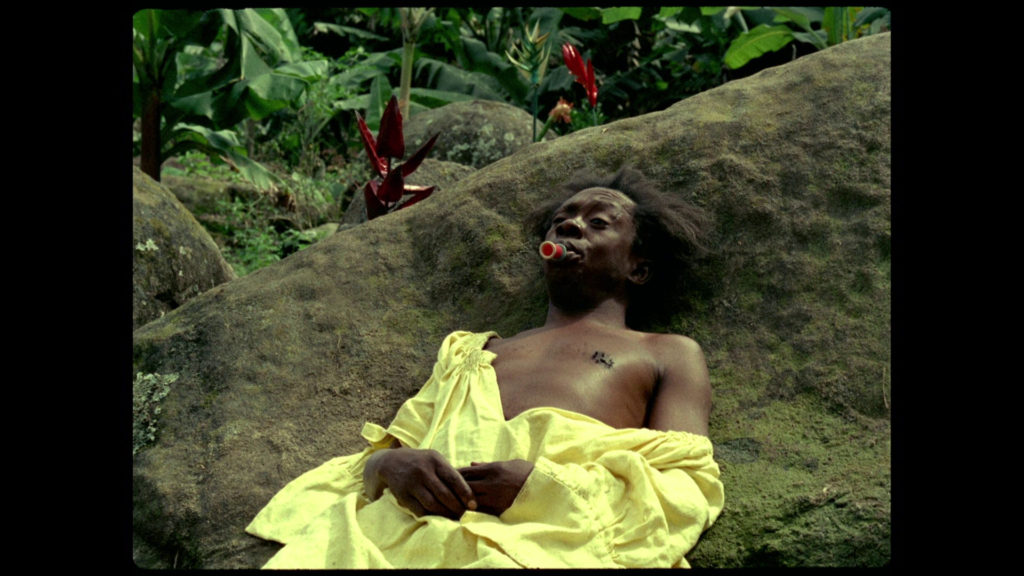
“The fortunate land of the Southern Cross”…
Aye… How the living heck to describe Macunaíma? One of the premiere films of the raucous third phase of Cinema Novo, the darkly comedic film trades in gaudy political symbolism and gawdawful outfits and settings. It begins and ends in a jungle, as a grown black dwarf-child (the uncanny and talented actor of Rio de Janeiro, Grande Otelo) plops suddenly from an old woman’s womb. This is our protagonist, the unlikable yet sadly pathetic Macunaíma. (Meaning “The big evil”, a deliberately cruel name). When everyone is bathing in the river and he blames his goosing of an attractive woman on crabs, she fires back, “There’s more shamelessness than crabs in here!” Ouch.
With no physical strength and even less of a work ethic, his small clan shorts him and slights him every chance they get, making him eat carcass refuse instead of yummy meat, et cetra. Don’t feel too sorry for the strange little guy, though. Soon enough he finds love, traveling partners, and a reason to leave his dismal home, a swampy, arid floodplain, for the Big City. After early temporary transformations into a ridiculous “handsome prince” give his non-existent love life a quick turnaround, a magical item later turns him into a white man (Paulo José) long term, and his already improving fortune improves all the more.
Ostensibly a comedy, if indicative of any kind of wider Brazilian sensibilities, Macunaíma serves as an eye-opening and unforgettable window into said cultural tastes. Oddly enough, research shows this to be the most important film of the set, thus explaining why the collection’s cover art is a modified version of Macunaíma’s cover, and also why Kino Lorber has since released it as a stand-alone release, one which appears to be the entirety of the Joaquim Pedro de Andrade: The Complete Films Disc 2.
*****
The Conspirators (1972)
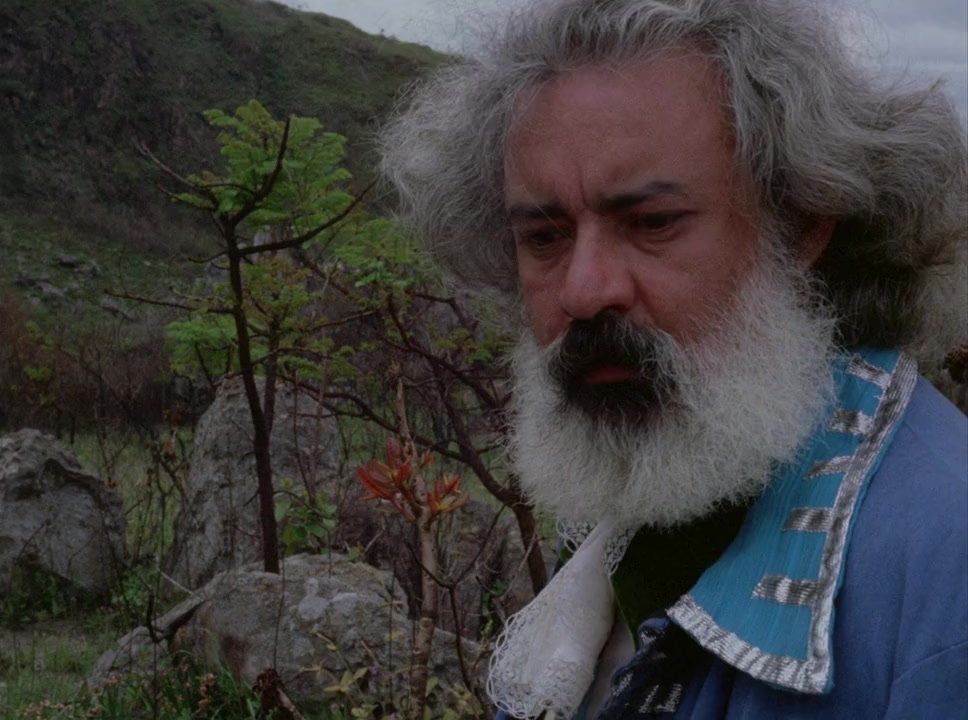
Inspired by “historical material and poems”, 1972’s The Conspirators is basically a spirited distillation of semi-recent Brazilian revolutionary figures. Far more specifically, and per the main description on the film’s IMDb entry, it is “a film version of the Minas Gerais Conspiracy, a separatist movement that took place on the year 1789, from its beginning to the execution of Tiradentes.”
The Conspirators is probably a better film than this terminally American critic is able to discern upon one viewing. This much, though, is clear: for its spirited distillation of semi-recent Brazilian revolutionary figures via only pre-existing historical materials and poems, it lands considerably more firmly than any of de Andrade’s other films. The filmmaker’s propensity for sharp edits during key actions is never more aptly utilized than it is here. All in all, The Conspirators, being in essence a costume drama of lofty assembly (made possible thanks to the major success of Macunaíma), lives on as de Andrade’s most prestigious feature film.
*****
Brasilia: Contradictions of a New City (1967)
Following an epic decision to shift the capitol city of Brazil from its two-centuries locale of Rio de Janeiro to a newly constructed intentional utopia, Brasília was founded in 1960. The best of the best of everyone and everything were shipped in, meant to render Brazil’s capitol a shining beacon of intellectualism, goods, industry, traffic flow, and culture. Although Brasília is still the capitol to this day, Joaquim Pedro de Andrade is here to explain why, only seven years following its establishment, it’s a failure. In this twenty-three minute full-color documentary, he makes good points about why that perception has proven valid for so many people. (Hint: a class hierarchy can’t help but emerge amongst a construct such as this). The film is a decent little bit of political enlightening, speaking its truth in the same rote narration style as the other such films in this set. The anger and resentment about Brasília, though, can be heard in his voice- and felt in the presentation.
The Language of Persuasion (1970)
The Language of Persuasion runs about ten minutes and functions entirely as an expose in the ways of mass media, specifically advertising. For anyone who’s spent any time at all with the most prominent works of Marshall McLuhan, this is 101 level stuff, if filtered through the sieve of Brazilian life circa it’s time of production. In fact, at its worst, The Language of Persuasion comes off as the work of someone who just read Understanding Media for the first time, and considers himself an expert. Not a great piece, and no doubt dated, but this being “The Complete de Andrade”, here it is.
*****
Disc 3
Conjugal Warfare (1975)
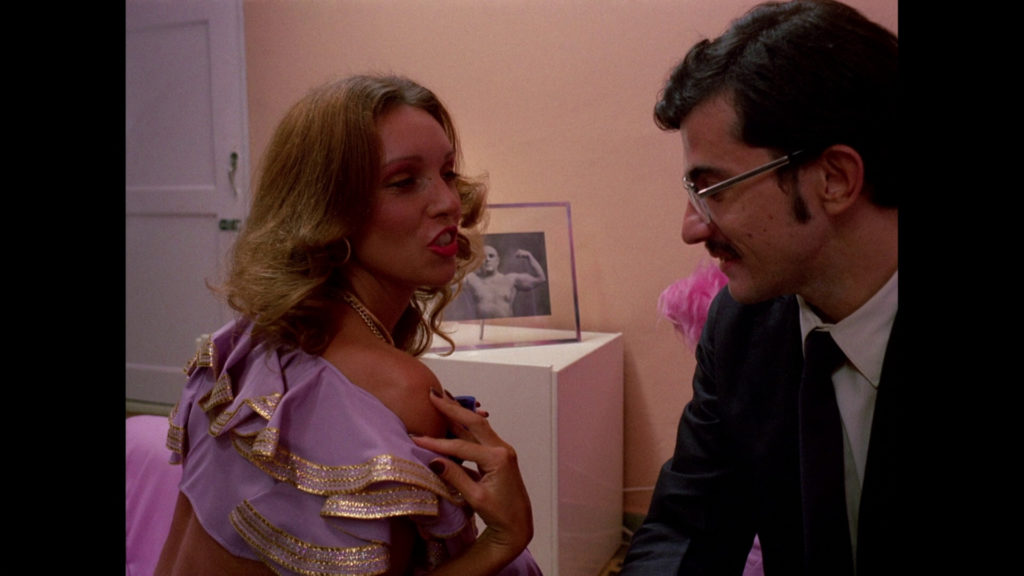
A strangely breezy bit of uneasiness, 1975’s Conjugal Warfare hops back and forth between a handful of characters and their relationships. With a title like “Conjugal Warfare”, one may correctly guess that the film is a kind of War of the Roses scenario. Yes, that; multiplied. If it’s possible for a film to be both misogynistic and progressive, Conjugal Warfare might just be a prime member of that filmmakers club; de Andrade himself at this point officially instated as a chief officer. Regarding the latter aspect, virtually no male comes through unscathed, every one of them some level of jerk deserving of his comeuppance. They’re all so abrasive, abusive in their words, sickeningly womanizing, or some combination thereof.
The women, far more sympathetic and humane, are also chronically victims of the men. They are frequently depicted wearing skimpy outfits or no clothes at all. Narratively, Conjugal Warfare is disheveled by design, an assembly of stories of various and unfortunate perversions, all tying back to the central couple, both of whom can’t live or without one another. All the while, the film’s low budget 1975-ishness is showing; an aesthetic that is appropriately dingy, grimy, and even greasy. Not un-amusing on the whole, Conjugal Warfare is a comedy of bitter coarseness.
*****
The Brazilwood Man (1981)

As a nightclub soiree is interrupted with revolutionist outbursts, a table of Catholic clergy stoically gets up and departs. In leaving, one sardonically turns to another, telling him, “You know, when God flooded the Earth, I think he made his only mistake: Noah.” By the end, naked revolutionaries will have conquered the day, a literal ship of fools set adrift. Aaaaand, credits. The movie’s over, and I for one am not quite sure what I just watched. (Don’t worry, in the case of this movie, this can’t possibly be a spoiler).
The final feature film in the set, The Brazilwood Man is nuts. Based on the work and life of Oswald de Andrade (no relation), it’s a disjointed and whackadoodle affair, and, like so much of de Andrade’s work, perhaps too rooted in its own blend of course satire and national politics. But it’s colorful, not of a small scale, and sporting a quicker pulse. Its impenetrability is, for the most part, also it’s off-puttingly sensual charm. But if you come away more exhausted than confused, you’re probably closer to processing the experience correctly. For the adventurous filmgoer (which, if you’ve made it this far…), The Brazilwood Man is a primary film of this set. Having never been there, one can only wonder if it feels like Brazil would, man.
*****
Two short films appear on disc three, and they almost couldn’t be more dissimilar…
O Aleijadinho (1978)
O Aleijadinho (The Little Cripple), is a twenty-four minute visual tour of various ornate cathedrals of Brazil, all adorned with the amazing sculptures of Antônio Francisco Lisboa (1738 – 1814). An artist of brilliant detail and tenacity, it is said that he received the nickname “Aleijadinho”, meaning “The Little Cripple” due to a degenerative illness contracted in 1777 which would mark the rest of his difficult life. Lisboa, though, persisted in his sculpting, through his intense pain. Hence, Lisboa became a Brazilian folk hero, best known for his work Twelve Prophets, which resides at the Sanctuary of Bom Jesus de Matosinhos at Congonhas. Perhaps most interestingly, it turns out that the legend, even the very existence of Aleijadinho is in question; perhaps the fabrication of a 1951 biographer. O Aleijadinho, though, isn’t about that. Rather, an authoritarian narrator speaks from the script about the Lisboa, his work, and where it resides. While the cathedrals and the artwork therein are tremendously impressive, this short film is, frankly, dull.
Tropical Lane (1977)
And then there’s Tropical Lane, a short narrative about a man who really loves watermelon. He really, really, really loves watermelon – not as a snack, either. A bizarrely sexual comedic short of twenty-five minutes, Tropical Lane takes and runs with its free love roots, ripening to wacky extremes. “To each their own” is the underlying attitude in this precursor to American Pie’s most memorable moment, playing like a superior outtake from Woody Allen’s Everything You Ever Wanted to About Sex but Were Afraid to Ask. Originally included as de Andrade’s contribution to the four-part Brazilian compilation film Erotic Stories (1980), here is it broken out and presented in the context of its maker’s full catalog.
*****
The essay by Fábio Andrade (no relation) in the set’s full-color printed booklet has a pretty good first half… Due to having been bizarrely misprinted (an error I hope is isolated in scope), the review copy covered here only has the first half- printed twice. Information on several of the films are also missing, replaced by duplicate full-page photos and summaries. While this misprint is most unfortunate in terms of lost information regarding a filmmaker that so many cinema buffs likely have little or no familiarity with, it is far from being a dealbreaker. (Though admittedly, this critic’s take would’ve no doubt benefited from having all the info).
Joaquim Pedro de Andrade died in 1988 at the age of fifty-six. For a filmmaker that launched as a somewhat promising blend of rote documentarian and Ingmar Bergman imitator, it’s quite interesting that he so quickly shifted his trajectory into a style far more reminiscent of latter Federico Fellini. Of course, being that the said latter era Fellini work was either happening concurrently as most of de Andrade’s filmmaking, it’s possible that de Andrade and the whole of Cinema Novo was actually influencing Fellini. Fellini, though remembered as an exceedingly personal filmmaker, often to the point of egotistical myopia, actually began his career also in the realm of the political, a later derivation of the Italian Neo-Realism movement. The Italian Neo-Realism movement inspired the formation of Cinema Novo.
De Andrade, at least to the newcomer, is most clearly a filmmaker of political flair. (This is backed up by his most accessible quotes being all about cinema as a political vehicle). When taken as whole, as presented here, the personal aspects become apparent, stepping forward from the diverse and collectively damaged psyche of post-Brazilia Brazil, and announcing itself in no uncertain terms. It is the very humanity- bright, gaudy, precise, colorful, desolate, unknowable, obvious and naked- that is the base motivation of this work, its very bottom-line reason for being.

The images used in this review with the exception of the main image are credited to DVDBeaver.com.


